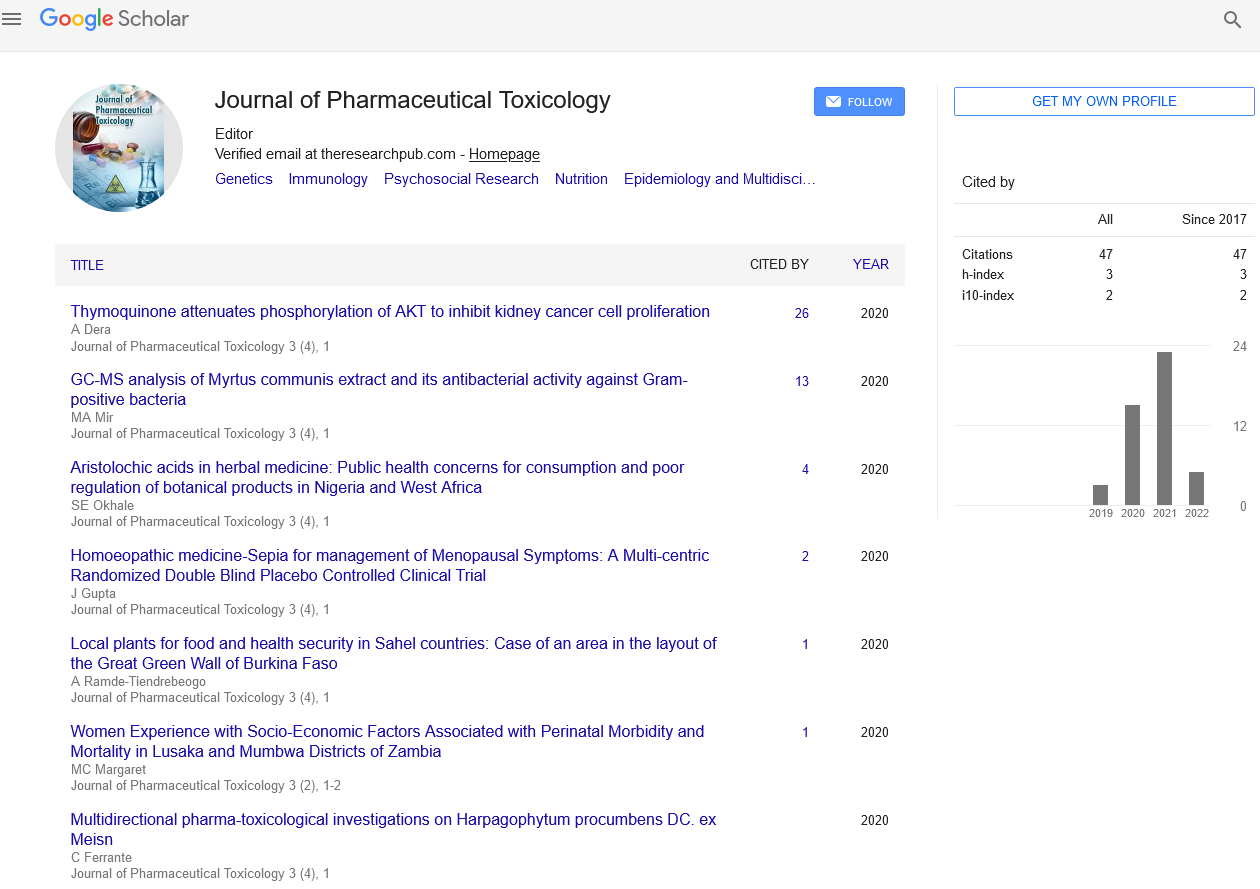Commentary - Journal of Pharmaceutical Toxicology (2022) Volume 5, Issue 3
Socioeconomic Aspects of Traditional Firewood for Cooking
Islas-Samperio*
Institute de Energías Renovables, Universidad National Autonoma de México, Privada Xochicalco S/N, Col. Centro, Temixco 62580, Mexico.
Received: 02-Jun-2022, Manuscript No. jpt-22-29851; Editor assigned: 06-Jun-2022, PreQC No. jpt-22- 298451(PQ); Reviewed: 20-Jun-2022, QC No. jpt-22-29851; Revised: 23- Jun-2022, Manuscript No. jpt-22- 29851(R); Published: 30-Jun-2022, DOI: 10.37532/jpt.2022.5(3).55-56
Abstract
Firewood is a solid biofuel that is widely used for cooking in Mexico’s residential sector. This study seeks to identify relevant factors in firewood consumption patterns, and their implications For climate change, gender, and health, and for energy poverty in Mexico, by climate region and Socioeconomic level. For this purpose, a statistical analysis was conducted of recently published Official information. We estimate that a total of 31.3 million Mexicans—26% of the total population— use firewood, and we have identified three main types of users: (i) exclusive firewood users (30%); (ii) mixed firewood users using firewood as their primary fuel (18%) and (iii) mixed firewood users using firewood as their secondary fuel source (52%). Total consumption of firewood was estimated at 116.6 PJ, while estimated greenhouse gas emissions were 8.1 million tCO2e. Out of all the households studied, 53% were in the tropical climate region; 59% were categorized as being in the “low” socioeconomic level; and 75% were in population centers comprising fewer than 2500 inhabitants. Some 68% of households do not pay for the acquisition of firewood, and for those households that do pay for the resource, estimated transactions total USD 286.9 million. Expenditures on firewood for energy represent up to 10% of household income.
Keywords
firewood • cooking • rural and peri-urban Mexican households • climate regions • socioeconomic level • climate change• health issues • gender equality • energy poverty
Introduction
The most widely used cooking fuels worldwide are liquid petroleum gas (LPG), natural gas and electricity, and biogas, as well as solar and alcohol cookers, which are considered clean fuels and technologies. However, LPG and natural gas, being fossil fuels, emit large amounts of greenhouse gases (GHG) and pollutants into the environment, and electricity could also directly generate these impacts on the environment depending on the fuel mix of the electric fleet. Thus, although LPG and natural gas could be called “modern” fuels, they are by no means “clean” fuels. According to, in 2019, 66% of the population had access to such fuels and technologies, while 2.6 billion people continue to cook with traditional biomass such as wood, charcoal, crop residues, dung and other traditional fuels such as coal and kerosene [1]. Thus, by 2019, traditional biomass consumption was estimated at 24.6 EJ, representing 6.5% of the world’s final energy consumption. Therefore, it is necessary to develop policies that increase the sustainability of firewood consumption in order to reduce the negative impacts on the environment and human health increase resilience, and mitigate the impacts of climate change.
Materials and Methods
During the first half of 2018, INEGI conducted The National Survey on the Consumption of Energy Sources in Private Housing Units. This is the first survey whose objective was to obtain and convey information regarding final energy consumption in the Mexican residential sector, and it asked respondents about the different types of fuels and devices employed in electrical and thermal energy consumption. This is because firewood is a traditional source of energy that is mainly consumed in the rural and peri-urban sectors, where firewood consumption patterns are changing slowly [2]. The second stage of the methodology is presented in and consists of a statistical analysis of annual per capita consumption of firewood and annual expenditure for acquiring firewood in those households where firewood is paid.
Description
Among all firewood users, TFS was the device for cooking and heating food that was preferred by the vast majority, with the improved biomass cook stove being the choice of a small minority. In the case of MU, devices using LPG were identified by the ENCEVI as follows: electric lighting stove, manual lighting stove, pilot-lighting stove, and gas grill. Between 18% and 33% of households pay for firewood, with the exception of CR-TR of SL-ML, which has 63% of paying users [3]. This latter percentage is close to the 73% of paying users reported for the state of Chiapas, which falls in CR-TR by Reference. This might mean that in Mexico’s tropical region, markets have developed for household firewood that have not yet been identified and studied.
Conclusions
Firewood continues to be an irreplaceable fuel and source of energy for cooking food in rural and peri-urban low-income populations living in a situation of energy poverty. Firewood users represent a high population percentage in rural and periurban areas. They can be classified into three types: (i) exclusive firewood users, (ii) mixed users where firewood is the primary fuel, and (iii) mixed users where firewood is the secondary fuel [4]. Type (i) and (ii) users have the highest per capita -using households in the population that has this expenditure. Among firewood users, women are the most affected by the negative health impacts of firewood consumption because they are the type (iii) users. Monetary expenditures to acquire firewood for cooking can represent significant percentages direct users and have fuel wood consumption and are mainly distributed in the tropical climate region, while type (iii) users predominate in the mild climate region [5]. There are few users in the extreme heat climate region; most are of the income of firewood the most prolonged exposure to pollutants from firewood combustion. If firewood is not regulated to be produced or harvested in a sustainable regime, its use could represent important GHG emissions and become significant in terms of climate change [6].
Acknowledgement
None
Conflict of Interest
No conflict of interest
References
- Biswas S, Das U. Adding Fuel to Human Capital: Exploring the Educational Effects of Cooking Fuel Choice from Rural India. Energy Econ.105, 105744, (2022).
- Gupta R, Pelli M. Electrification and Cooking Fuel Choice in Rural India. World Dev. 146, 105539, (2021).
- Li M, Jin T, Liu S, Zhou S et al. The Cost of Clean Energy Transition in Rural China: Evidence Based on Marginal Treatment Effects. Energy Econ. 97, 105167, (2021).
- Akintan O, Jewitt S, Clifford M. Culture, Tradition, and Taboo: Understanding the Social Shaping of Fuel Choices and Cooking Practices in Nigeria. Energy Res Soc Sci. 40, 14–22(2018).
- Astuti S P, Day R, Emery S B. A Successful Fuel Transition? Regulatory Instruments, Markets, and Social Acceptance in the Adoption of Modern LPG Cooking Devices in Indonesia. Energy Res Soc Sci. 58, 101248(2019).
- Ramírez Candia J, Curt M D, Domínguez J. Understanding the Access to Fuels and Technologies for Cooking in Peru. Energies,15, 1456(2022)
Indexed at, Google Scholar, Crossref
Indexed at, Google Scholar, Crossref
Indexed at, Google Scholar, Crossref
Indexed at, Google Scholar, Crossref


